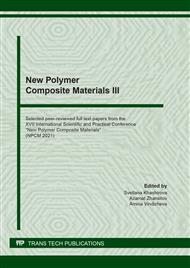[1]
Z. Zhao , K.K.C. Ho, S.R. Shamsuddin, A. Bismarck, V. Dutschk, A comparative study of fibre/matrix interface in glass fibre reinforced polyvinylidene fluoride composites, Colloids Surf. A Physicochem. Eng. Asp. 413 (2012) 58-64.
DOI: 10.1016/j.colsurfa.2012.02.018
Google Scholar
[2]
S.G. Prolongo, G.D. Rosario, A. Urena, Comparative study on the adhesive properties of different epoxy resins Int. J. Adhes. Adhes. 26 (2006) 125-132.
DOI: 10.1016/j.ijadhadh.2005.02.004
Google Scholar
[3]
K. Toshiya, D.T. Lawrence, Carbon fiber/epoxy composite property enhancement through incorporation of carbon nanotubes at the fiber-matrix interphase. Pt I. The development of carbon nanotube coated carbon fibers and the evaluation of their adhesion, Composites. A. 43 (2012) 1569-1577.
DOI: 10.1016/j.compositesa.2012.02.016
Google Scholar
[4]
L-M. Zou. Caroline Baillie, and Yiu-Wing Mai, J. Mater.3a. B. Z. Jang, Advanced Polymer Composites, Principlesand Applications ASM International, Materials Park, Ohio. (1994) 37.
Google Scholar
[5]
Mikhailin Yu.A., Structural polymer composite materials. – SPb.: Scientific foundations and technologies, (2008).
Google Scholar
[6]
W. Hefer. Adhesion in Bitumen-Aggregate System and Quantification of The Effects of Water on The Adhesive Bond. (2004).
Google Scholar
[7]
A.I. Kurilenko, L.B. Aleksandrova, Determination of the wetting angle of the fibers, Khimicheskie Volokna. 3 (1965) 65-67.
Google Scholar
[8]
V.I. Prigorodov, L.P. Kobets, T.I. Lysenkova, Determination of the wetting angle of thin fibers with liquids Khimicheskie Volokna. 5 (1976) 71-72.
Google Scholar
[9]
Q. Bénard, M. Fois, M. Grisel, Roughness and fibre reinforcement effect onto wettability of composite surfaces. Appl Surf Sci. 253 (2007) 4753–8.
DOI: 10.1016/j.apsusc.2006.10.049
Google Scholar
[10]
A. H. Saputra, D. P. Hallatu, The characteristic of unsaturated polyester resin wettability toward glass fiber orientation, density and surface treatment. MATEC Web of Conferences. 101 (2017) 01014.
DOI: 10.1051/matecconf/201710101014
Google Scholar
[11]
I. Musov, A. Slonov, A. Zhansitov, D. Khakulova, S. Khashirova, Influence of concentration of carbon and glass fibers, melt viscosity, and number of extrusions on the porosity of composites based on polyphenylene sulphone, polyethyrimide and polyphenylene sulfide, Key Engineering Materials. 869 KEM (2020) 481–487.
DOI: 10.4028/www.scientific.net/kem.869.481
Google Scholar
[12]
A. Slonov, I. Musov, E. Rzhevskaya, A. Zhansitov,S. Khashirova, Investigation of the effect of the length and content of carbon fibers on the properties of polyphenylene sulfide, Key Engineering Materials. 869 KEM (2020) 474–480.
DOI: 10.4028/www.scientific.net/kem.869.474
Google Scholar
[13]
Information on https://polimer1.ru/catalog/vysokoeffektivnye-polimery/polifenilensulfid-tecatron-pps.
Google Scholar
[14]
D.A. Soules, R.L. Hagenson, Résines de polysulfures d'arylène renforcés avec des fibres de verre. EР Patent 0524343. (1991).
Google Scholar
[15]
Y. Zhang, Long glass fiber reinforced thermal insulation polyphenylene sulfide composite material and preparation method thereof, СN Patent 102898835 (2011).
Google Scholar
[16]
Y. Zhang, Zh. Zhang, J. Zhang, F. Ye, J. Luo, L. Han, Glass fiber reinforced polyphenylene sulfide resin composite material, CN Patent 101864169B (2009).
Google Scholar
[17]
J. Wang, T. Zhang, J. Zhang, Y. Niu, Zh. Liu, Wear-resistant low-floating fiber glass fiber-reinforced polyphenylene sulfide composite material and preparation method thereof. CN Patent 106380846A. (2016).
Google Scholar
[18]
K. Sever, M. Sarikanat, Y. Seki, I.H. Tavman, Concentration effect of γ-glycidoxypropyltrimethoxysilane on the mechanical properties of glass fiber-epoxy composites, Polymer Composites. 30 (2009) 1251–1257.
DOI: 10.1002/pc.20686
Google Scholar
[19]
Z. Liu, Y.Q. Wu, X.J. Wang, S.R. Long, J. Yang, Effects of the Coupling Agent on the Mechanical Properties of Long Glass Fiber Reinforced Polyphenylene Sulfide Composites, Materials Science Forum. 815 (2015) 509–514.
DOI: 10.4028/www.scientific.net/msf.815.509
Google Scholar
[20]
J.Yang, Q. Zhang, K. Zhang, X. Wang, G. Zhang, Reinforced composite material based on polyphenylene sulfide and a method for its production, CN Patent 103665867 (2006).
Google Scholar
[21]
G.Wang, X. Chen, J. Yang, Q. Wang, High temperature resistant high strength reactive reinforced and hardened composite based on polyphenylene sulfide, CN Patent 102942790 (2012).
Google Scholar
[22]
H.-H. Ren, D.-X. Xu, T. Yu, J.-C. Yang, G. Zhang, X.-J. Wang, J. Yang, Effect of polyphenylene sulfide containing amino unit on thermal and mechanical properties of polyphenylene sulfide/glass fiber composites, Journal of Applied Polymer Science. 135 (2017) 1-10.
DOI: 10.1002/app.45804
Google Scholar
[23]
Z. Liu, S. Zhang, G. Huang, K. Zhang, X. Wang, G. Zhang, J. Yang, Effects of polyarylene sulfide sulfone on the mechanical properties of glass fiber cloth-reinforced polyphenylene sulfide composites, High Performance Polymers. 27 (2015) 145–152.
DOI: 10.1177/0954008314541789
Google Scholar
[24]
Y. Kong, J. C. Yang, X. J. Wang, G. Zhang, S. R. Long, J. Yang, Preparation and Mechanical Properties of Poly (arylene sulfide sulfone)/Glass Fiber Cloth Composites. Materials Science Forum. 815 (2015) 496–502.
DOI: 10.4028/www.scientific.net/msf.815.496
Google Scholar
[25]
K.T. Shakhmurzova, Zh.I. Kurdanova, A.A. Zhansitov, Z.Z. Shaoeva, R. Kh. Shabatokova, R.Z. Kuchmenova, S.Yu. Khashirova, Synthesis and properties of polyphenylene ether sulfide sulfones, Proceedings of the Kabardino-Balkarian state university. 1 (2017) 59-62.
DOI: 10.3390/ma15186381
Google Scholar


